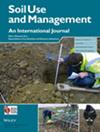Compaction behaviour of a sandy road base contaminated with microplastics from vehicle tires
IF 3.7
3区 农林科学
Q1 SOIL SCIENCE
引用次数: 0
Abstract
Disintegrated tire particles can easily be transferred into the road bases because of the abrasion of vehicle tires on roads. The fragmented tire particles that have a grain size of smaller than 5 mm can be expressed as microplastics. In order to simulate the tire chip microplastic concentration in a sandy road base and assess the effect of microplastics on the compaction degree of the road base, standard Proctor compaction tests were performed on 0.05%, 0.1%, 0.2%, 0.4%, 1%, 2%, 4% and 8% tire chip microplastics‐amended sandy soil by dry mass. Results showed that maximum dry unit weight (受汽车轮胎微塑料污染的砂质路基的压实性能
由于车辆轮胎对路面的磨损,碎裂的轮胎颗粒很容易转移到路基中。粒径小于 5 毫米的破碎轮胎颗粒可以表示为微塑料。为了模拟轮胎碎片微塑料在砂质路基中的浓度,并评估微塑料对路基压实度的影响,对轮胎碎片微塑料添加量分别为 0.05%、0.1%、0.2%、0.4%、1%、2%、4% 和 8%的砂质土壤进行了标准 Proctor 压实试验。结果表明,随着轮胎碎片微塑料浓度增加到 0.4%,砂土的最大干单位重量(ɣdmax)从 16.04 kN/m3 增加到 16.99 kN/m3。微塑料浓度的进一步增加导致ɣdmax 下降。相反,当轮胎碎片微塑料浓度增加到 0.4% 时,最佳含水量(wopt)从 15.9% 降至 12.5%。微塑料浓度的进一步增加导致 wopt 增加。考虑到这些结果,我们发现 0.4% 的轮胎屑微塑料浓度是提高压实度的最佳用量。除了有助于砂质路基的稳定之外,轮胎碎片微塑料还可以从环境保护的角度进行评估。由于压实作用,这些微塑料被迫堆积在沙中。因此,它们不会轻易转移到可能威胁人类健康和造成环境污染的水资源或农产品中。
本文章由计算机程序翻译,如有差异,请以英文原文为准。
求助全文
约1分钟内获得全文
求助全文
来源期刊

Soil Use and Management
农林科学-土壤科学
CiteScore
7.70
自引率
13.20%
发文量
78
审稿时长
3 months
期刊介绍:
Soil Use and Management publishes in soil science, earth and environmental science, agricultural science, and engineering fields. The submitted papers should consider the underlying mechanisms governing the natural and anthropogenic processes which affect soil systems, and should inform policy makers and/or practitioners on the sustainable use and management of soil resources. Interdisciplinary studies, e.g. linking soil with climate change, biodiversity, global health, and the UN’s sustainable development goals, with strong novelty, wide implications, and unexpected outcomes are welcomed.
 求助内容:
求助内容: 应助结果提醒方式:
应助结果提醒方式:


